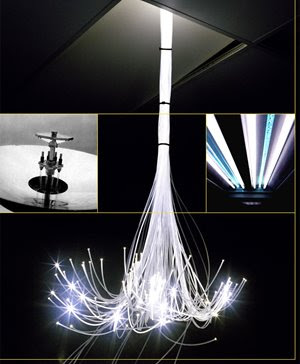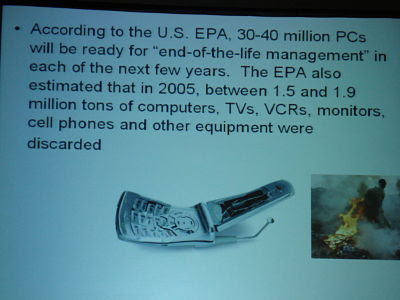
Now that I’ve finally loaded the Mac, all the awesome facts we were just reading are gone. A summation:
With all the corporate computers running through the night, you can just imagine how much energy is wasted. We can all do our part. For example, look at this slide on how much we waste physical materials that can easily be recycled:
We usually focus on saving money by turning off lights and conserving water and resources, but why don’t we think about ways use computers/technology more efficiently? Here’s what several companies are focusing on going Green with:
MOBILITY: Visit websites like iHitchhiking.com, itrago.com, and zipcar,com which basically allow you to connect with others to carpool and use car-sharing services. Couple this with Smart Charging, and you’re completely ready to Go Green.
HOMES: Devices like MyTemp and LagoTek provide services to selectively save energy and view energy use in your homes (via Smart Metering, Consumer Powerline). You can control energy use yourself, tweak it, or have a computer control it for you.
GADGETS: Green companies like Remix Modular Design allow you to recycle the base materials in products like cell phones so you don’t have to throw away as many materials when you get a new one. One alternative energy company called M2epower makes a microgenerater which captures your movement and actually converts this into kinetic energy. A device called High Mini attaches to bikes and stores and captures wind energy for later use!
MATERIALS: Some ways companies are converting materials into energy: Ferro Solutions takes waste CO2 and turns it into plastic. The Space-age looking car made by Intera puts solar cells on the roof that power the AC. There’s also a company called Voltaic that makes backbacks with solar panels which charge batteries, cell phones, and lap tops (cost about $200 right now).
HIDDEN CITIES: It’s kind of like a recreation of the Matrix or something – creating atmospheric data into visualizations. Nokia EcoSensor sees how people interact within cities by giving users a SimCity-like interface on their cell phones that provide real-time access to emissions, pollutants, pollen counts, vapor levels, etc. Google Earth and Google Maps is used to plot and visualize hazardous areas or avoid potential destructive paths. Google is actually making great progress in actively seeking green ideas and organizations to use in tandem with their product.
Now for some specific Green Gadgets:
An energy-saving adaptor (didn’t get the name) that measures the amount of energy your device is using. Basically, it’s an Apple-looking power strip that plugs into the wall and tells you when the devices are charged. She also talked about an electronic device called Wattson by DIY Kyoto measures home energy use in unit of currency or wattage.
A pull-cord generator made by Potenco gives about 20 minutes of talk time on a mobile phone or 1 hour of ultrabright LED light just by pulling a cord for 1 minute.
One company is creating wind-up cell phones called Bamboo Phones. The material is actually made from bamboo (go figure). But seriously, bamboo! It uses an internal manual crank to generate power – they don’t generate a lot of power right now, but we can see a lot of potential here.
This one was probably my favorite – a hybrid solar lighting system which uses solar collectors that stretch from your rooftop into your building via fiber optic cables. It provides mood-boosting daylight wired into any room in your house.
Look for more Green Gadgets here
Greenwashing: The act of misleading consumers regarding the environmental practices of a company or the environmental benefits of a product or service. The Six Sins of Greenwashing can be found at http://www.terrachoice.com


Permalink
great coverage, I have never really thought about this topic much, —the hybrid solar lighting..wind up cell phones….producing energy on ur bike? crazee fun
Permalink
I know working for a newspaper I sometimes get the inclination that I am a tree murderer. We don’t even used recycled paper. I know some newspapers out there use recycled paper, and I don’t what to give the impression that all newspapers are un-sensitive dinosaurs. But the fact remains that the newspaper industry has a long way to go before they gogreen.
Often an aspect overlooked is the environmental impact the Internet has had on newspapers. As we watch circulation numbers drop, and print production cost sky rocket newspapers will have no other choice then to go paperless, and discover new ways maintain their lucrative profit margins.